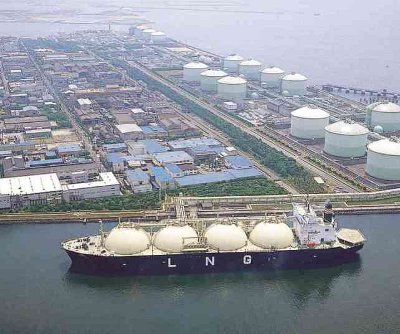Friday, a joint venture was announced that would represent Japan’s first crack at U.S. liquefied natural gas (LNG). It also marks the increasing eagerness to export natural gas from U.S. shorelines.
Mitsui & Co. (OTC: MITSY), Mitsubishi Corp. (OTC: MSBHY), and Nippon Yusen K.K. (OTC: NPNYY) will each take stake in the construction of an export facility as part of Cameron LNG’s terminal in Hackberry, Louisiana.
The export facility will cost roughly $10 billion. Mitsui will take a 16.6 percent stake, while the other two companies will jointly take another 16.6 percent.
 U.S.-based Sempra Energy (NYSE: SRE), developer and coordinator of the Cameron LNG project, will retain 50.2 percent of the project, and France’s GDF Suez SA will hold the remainder in the deal.
U.S.-based Sempra Energy (NYSE: SRE), developer and coordinator of the Cameron LNG project, will retain 50.2 percent of the project, and France’s GDF Suez SA will hold the remainder in the deal.
In a separate statement, a 20-year tolling agreement was reached with Mitsui, Mitsubishi, and GDF Suez to secure fuel from the facility.
Mitsui is Japan’s second largest trading company and hopes to generate a stable energy supply in the coming years; same with Mitsubishi. Nippon Yusen, which is already Japan’s leading world trader with its biggest shipping line, will be instrumental in LNG imports for Japan.
GDF Suez is Europe’s biggest LNG importer, already importing 16 million tons every year. With its 6 tankers, the company has high hopes from trade lines with the U.S.
Talks began between Sempra, Mitsubishi, and Mitsui in 2012. Now, with all players set to go, construction will begin next year, with final approval by regulation committees set for early 2014. The project should see its first phase of operation in 2017.
U.S. LNG to Japan
After Japanese natural disasters left all but two of the nation’s nuclear reactors down and out in 2011, Japan has been feverishly securing energy supplies.
This agreement in particular is important for Japan, as demand for natural gas and LNG is expected to grow globally.
Japan is currently facing rising fuel costs and has made it a point to be part of the Trans-Pacific Partnership trade agreement that includes 11 Asian countries and the Americas.
One reason the U.S. supply is so attractive for Japan is because its gas is priced using the Henry Hub. The U.S. benchmark is set much lower than oil-indexed prices in other LNG supply contracts.
Japan, which stands as the world’s leading gas importer, currently pays between three and four times what it would pay to trade with the likes of Louisiana and other U.S. suppliers.
And that’s because the shale gas boom has seen production soar in recent years, driving U.S. natural gas prices down.
But that rampant production has left this administration with cold feet on moving its gas to countries that aren’t part of the free-trade agreement. This deal signifies that the U.S. is ready to test the waters, at least for the short term.
Billions of dollars have now been committed to doing so, as the U.S. hopes it will provide economic benefits and strengthen its global influence.
Our analysts have traveled the world over, dedicated to finding the best and most profitable investments in the global energy markets. All you have to do to join our Energy and Capital investment community is sign up for the daily newsletter below.
Twenty-six U.S. LNG projects have currently applied for export permits from the Department of Energy. Before Friday, only one – Cheniere Energy’s (NYSE: LNG) Sabine Pass in Louisiana – had been given the right to export LNG to countries outside of the trade agreement.
Now, in addition to Sabine Pass, the Freeport LNG terminal in Texas will also have permission to freely trade its LNG with the likes of Japan and members of the European Union (EU).
It has been two years since the U.S. budged on approval of such matters.
Freeport has deals set in place with Japan’s Osaka Gas and Chubu Electric, as well as BP plc (NYSE: BP) of the U.K.
With last week’s breakthrough in U.S. LNG exports, the U.S. Department of Energy is expected to work through the remaining applications, with the Cameron LNG at the forefront of the list.
Mitsubishi alone is in negotiations with many companies to sell LNG from the Cameron project site.
Tokyo Electric Power Company said in February that it will likely buy 800,000 metric tons of Cameron LNG per year from Mitsui and Mitsubishi.
Looking Ahead
President Obama has taken his share of heat during his careful consideration to export natural gas.
The chemical and steel industries have been very local about urging restrictions on gas exports. Many who oppose exports say it will take away the competitive advantage the U.S. currently holds over much of the world on cheap energy.
But it looks like it’s a go. The Department of Energy plans to assess the markets in one year’s time, and from there it will make a more conscious decision on U.S. LNG exports for the future.
It might push gas prices higher, and it might not; but it’s go time for U.S. LNG exports.
If you liked this article, you may also enjoy:




